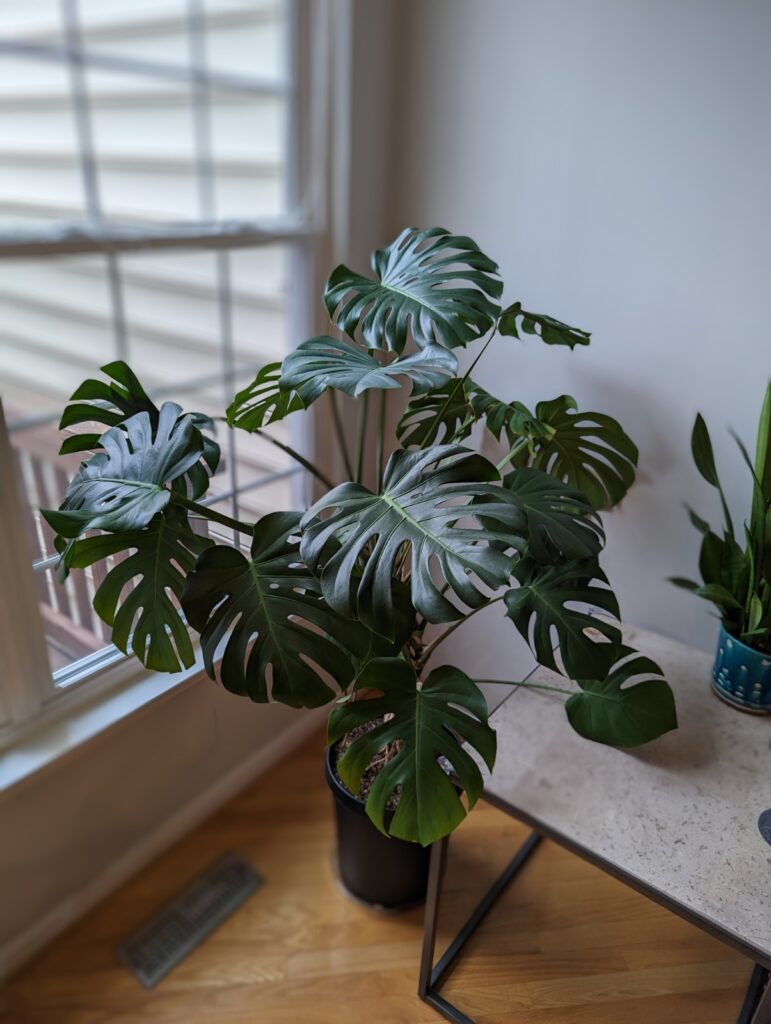Monstera Deliciosas are a popular vining houseplant. They are well known for their split leaves, which is not an issue, but a desirable trait. Monstera plants are also relatively fast growers that are easy to care for. A significant factor in helping your Monstera Deliciosa develop fenestration (the leaf splits) is to make sure that it’s receiving enough light. In this post, I’ll cover the ins and outs of Monstera Deliciosa light requirements.

Monstera Deliciosa Light Requirements
Monstera Deliciosas do best in bright indirect sunlight. The best way to provide your Monstera bright indirect light is to keep it near a window, preferably a west or east-facing window. To make sure the light is indirect, it’s best if the windows have sheer shades or some trees outside that filter the light a little bit. Providing indirect light is especially important if you have a south-facing window. South-facing windows get the most intense sunlight for the longest amount of time compared to other window directions. Monstera leaves have a lot of surface area and are susceptible to being burnt if they receive too much light
Monsteras grow quickly and can become quite large. That can make it difficult for people to find a good spot to keep them in their houses. If you prefer to keep your Monstera further from the window, or it just won’t fit next to the window, it will still survive. Monsteras can adjust to lower levels of light.
Monstera Deliciosa Light Changes
If you need to move your Monstera to a spot where it will be receiving a different amount of light, then you need to know about acclimating it. An example of when you might need to acclimate your Monstera would be when you’re bringing it home from the store or if it is next to a window and you want o move it further away. If a Monstera is moved into brighter light or lower light too quickly it may exhibit signs of shock. Shock may manifest in many different forms which I’ll discuss in the next sections. To avoid shocking your Monstera, you should move it gradually to its new spot. A good rule of thumb to follow is to move it about a foot a day toward its new spot. If you move your Monstera outside for the summer, many people take a different tactic. They expose their Monstera to the outdoor levels of light for a few hours a day and gradually increase the number of hours each day until it can be left outside 24/7.
Monstera Deliciosa Sunburn
Sunburn is less common for Monsteras that are kept indoors all the time, but it can happen. Sun damage is most likely to happen to a Monstera that has been moved outdoors. If you choose to summer your Monstera Deliciosa outdoors, you need to heed my advice about acclimating it to the outdoor sun gradually. Sunburn is not ideal but it’s not typically something that will completely kill your plant. Sunburn will appear as scorched-looking spots on the leaves. Scorched spots will happen anywhere on the leaf surface, not just the tips. If you’re seeing discoloration just on the tips, that’s more likely a water issue. Sunburned leaves can even look pale or bleached out. Sunburn is most likely to show up on the topmost leaves rather than the lower ones.
Monstera Deliciosa Low-Light
Monsteras can survive in lower-light environments, but they won’t look as good. As I mentioned earlier, Monsteras are known specifically for their fenestration. When they don’t receive adequate light, the leaves will be smaller and they will not develop fenestration. Don’t panic if the new leaves on your Monstera are not developing fenestration. Monsteras also need to reach a certain level of maturity to have the signature holes in the leaves. So if your Monstera is still small, it may not be ready to fenestrate.
In addition to lacking fenestration, a Monstera that isn’t receiving enough light will grow smaller-sized leaves. If the leaves on your Monstera are not getting progressively larger, then it’s probably not getting enough light. In addition, Monsteras that are not receiving enough light will grow at a slower rate. That’s why houseplants often go dormant in the winter because they are not receiving enough sunlight.
Plant Light Meter
If you’re interested in determining light levels in your house, I highly suggest this light meter. This particular plant monitor measures light, moisture, and nutrients. I find it to be superior to most light meters in the same price range because it lets you track the amount of light by the hour. That means you can track both the intensity of light and the number of hours of light you get and both matter. Other light meters in this price range only give you the light measurement at a single point in time, like when you’re physically looking at the meter. Read my in-depth write-up on this plant monitor if you’re interested in learning more.

I'm a long time plant lover on the quest to happily coexist with as many plants as I can. Let's grow!
